The San Millán Yuso and Suso Monasteries are located in San Millán de la Cogolla, a village near Burgos in Spain. The San Millán Suso Monastery was founded by San Millán in the 6th century. The monastery consists of hermits' caves and a church. The Yuso Monastery was founded in the 16th century. The sacristy of San Millán Yuso is considered as one of the most beautiful in Spain. The church is the pride of San Millán Yuso. During the fall and spring equinox, the sun shines through a rose window and then through the circle above this doorway to make a perfect circle of sunlight on the church floor of the monastery. The Glosas Emilianenses was written in the Suso Monastery in the 9th and 10th centuries by a monk, he added marginal notes in Castilian and Basque, the first examples of written Spanish. The San Millán Yuso and Suso Monasteries are considered to be the birthplace of the Spanish language. The monasteries became a place of pilgrimage in the 6th century. In the 14th century, the San Millán Yuso Monastery was looted by the English Prince Edward of Woodstock, known as the Black Prince, and in 1809 by the army of Napoleon Bonaparte. The monasteries are located along the famous Way of St. James to the town of Santiago de Compostela. The San Millán Yuso and Suso Monasteries gained the status as a UNESCO World Heritage in 1997.
www.werelderfgoedfotos.nl © Copyright World Heritage Photos
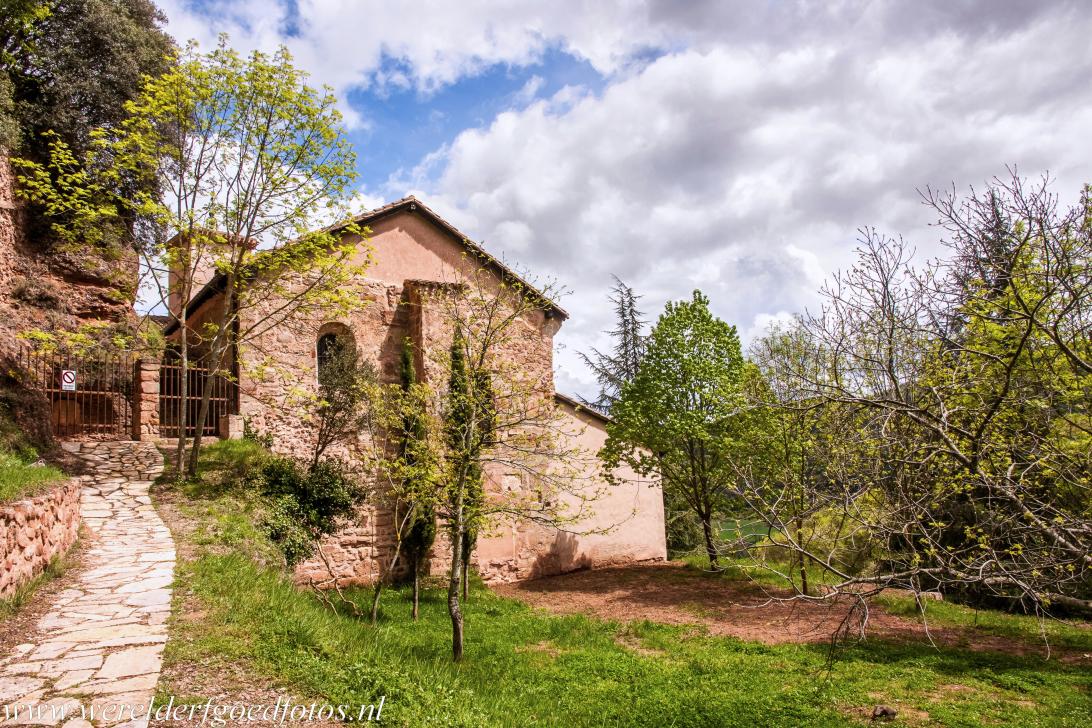
San Millán Yuso and Suso Monasteries: In the 6th century, the San Millán Suso Monastery was founded by the hermit San Millán. The monastery consists of a few hermits' caves and a church in the Visigoth, the Mozarabic and Romanesque styles. The church was built in honour of San Millán. The San Millán Yuso and Suso Monasteries are known as the birthplace of the written Spanish language. The San Millán Yuso and Suso Monasteries are a UNESCO World Heritage.

San Millán Yuso and Suso Monasteries: In the 6th century, the San Millán Suso Monastery was founded by the hermit San Millán. The monastery consists of a few hermits' caves and a church in the Visigoth, the Mozarabic and Romanesque styles. The church was built in honour of San Millán. The San Millán Yuso and Suso Monasteries are known as the birthplace of the written Spanish language. The San Millán Yuso and Suso Monasteries are a UNESCO World Heritage.
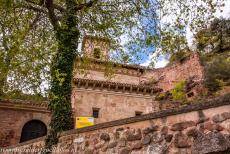
San Millán Yuso and Suso Monasteries: The San Millán Suso Monastery has two naves separated by horseshoe arches. The Glosas Emilianenses was written in Latin in the Suso Monastery in the 9th and 10th centuries by a monk, he added marginal notes in Castilian and Basque, this is the first known example of the written Spanish language. The monasteries are considered to be the birthplace of the written and spoken Spanish language.
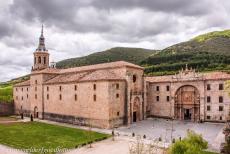
San Millán Yuso and Suso Monasteries: The San Millán Yuso Monastery is situated close to the village of San Millán de la Cogolla near Burgos in Spain. The Yuso Monastery was founded by the king of Najera, it was built in the 16th century. The monastery church has three naves. The Yuso Monastery is situated in a valley, the Suso Monastery is situated on a wooded hill. Yuso means 'lower' and Suso means 'upper'.
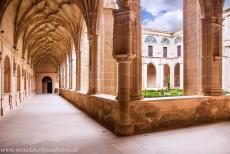
San Millán Yuso and Suso Monasteries: The courtyard and the Gothic cloister of San Millán Yuso. The main buildings of the San Millán Yuso Monastery were built around the Patio de la Luna, a small cloister, and the larger San Millán cloister, the main cloister. The San Millán Yuso and Suso Monasteries are situated along the pilgrimage route to Santiago de Compostela, also known as the Way St. of James, or in Spanish the Camino de Santiago.
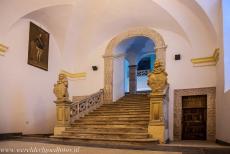
San Millán Yuso and Suso Monasteries: The Royal Staircase in the San Millán Yuso Monastery. In the Middle Ages, the San Millán Yuso and Suso Monasteries became major centres of cultural and political power, numerous religious and secular books were copied and illustrated. The library of the San Millán Yuso Monastery is conserved as it was at the end of the 18th century. Nowadays, it is one of the most important libraries in Spain and houses priceless books.
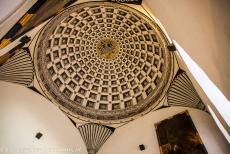
San Millán Yuso and Suso Monasteries: The decorated ceiling above the Royal Staircase in the San Millán Yuso Monastery. The Yuso Monastery was founded by the king of Najera in the 16th century. At that time, monarchs had their own living quarters in a monastery, used to spend the night while traveling through their country. The Monarch's Chamber is situated near the Royal Staircase.
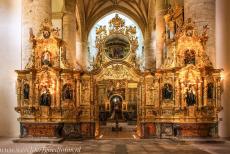
San Millán Yuso and Suso Monasteries: The church is the pride of San Millán Yuso, it was built between 1504 and 1540. The golden doors create a separation between the two parts of the church. Behind the doors is a large altarpiece, the Retablo Mayor. During the fall and the spring equinox, the sun shines through a rose window and then through the circle above the doorway to make a perfect circle of sunlight on the church floor of the San Millán Yuso Monastery.
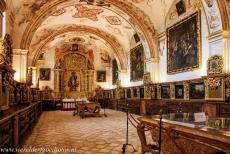
San Millán Yuso and Suso Monasteries: The sacristy of the San Millán Yuso Monastery dates to the 16th century. The sacristy is dedicated to Our Lady. The ceiling of the sacristy is decorated with 18th century frescoes, the floor is made of alabaster. The colour fastness of the frescoes on the ceiling is remarkable. The sacristy of the San Millán Yuso Monastery is considered as one of the most beautiful sacristies in Spain.
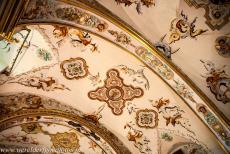
San Millán Yuso and Suso Monasteries: A detail of the ceiling frescoes in the sacristy of the San Millán Yuso Monastery. San Millán Yuso is still in use as a monastery, it is occupied by a small community of Augustinian monks, a part of the monastery building has now been converted into a hotel. The San Millán Suso Monastery was already abandoned in the 19th century. The San Millán Yuso and Suso Monasteries became a major place of pilgrimage in the 6th century.
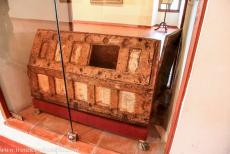
San Millán Yuso and Suso Monasteries: This 11th century chest was made for the relics of San Millán. It was decorated with 24 ivory panels. The ivory panels, gold and precious stones were stolen by soldiers of the army of Napoleon Bonaparte in 1809. In the oratory of the San Millán Monastery remain thirteen original ivory panels. In the 14th century, the monastery was looted by the English Prince Edward of Woodstock, later known as the Black Prince.
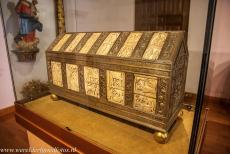
San Millán Yuso and Suso Monasteries: The ivory panels of the original relic chest of San Millán were stolen by soldiers of the army of Napoleon Bonaparte in 1809. A new chest was made for the relics of San Millán. The ivory panels represent the life of the hermit San Millán, the founder of the San Millán Suso Monastery. This relic chest is housed in the San Millán Yuso Monastery.
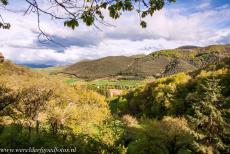
The San Millán Yuso Monastery (lower monastery) viewed the from San Millán Suso Monastery (upper monastery). The San Millán Yuso and Suso Monasteries are located in the small village of San Millán de la Cogolla, about 88 km east of Burgos in Spain. Both monasteries can be visited, but only by guided tour. In 1997, the San Millán Yuso and Suso Monasteries were inscribed on the UNESCO World Heritage List.
